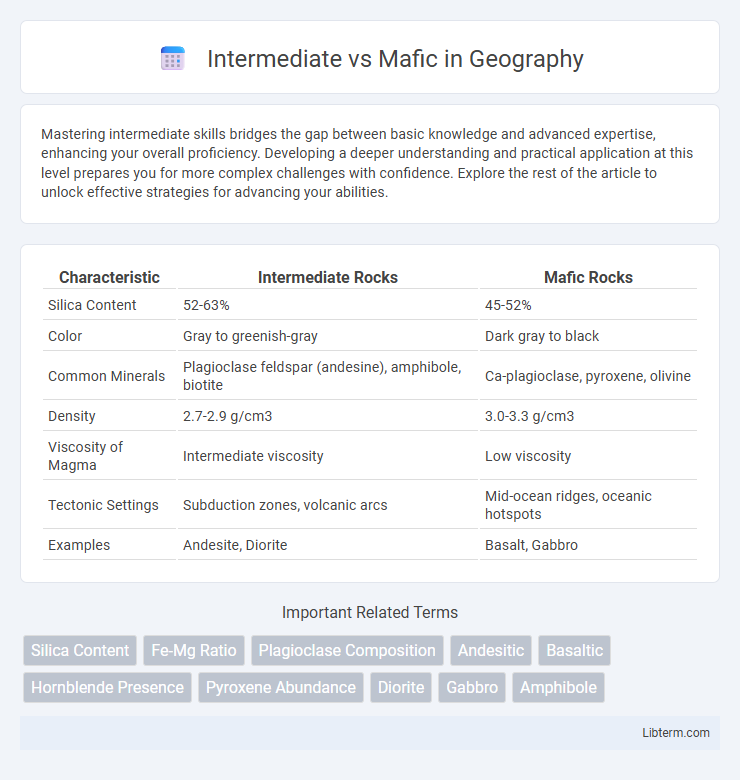Mastering intermediate skills bridges the gap between basic knowledge and advanced expertise, enhancing your overall proficiency. Developing a deeper understanding and practical application at this level prepares you for more complex challenges with confidence. Explore the rest of the article to unlock effective strategies for advancing your abilities.
Table of Comparison
| Characteristic | Intermediate Rocks | Mafic Rocks |
|---|---|---|
| Silica Content | 52-63% | 45-52% |
| Color | Gray to greenish-gray | Dark gray to black |
| Common Minerals | Plagioclase feldspar (andesine), amphibole, biotite | Ca-plagioclase, pyroxene, olivine |
| Density | 2.7-2.9 g/cm3 | 3.0-3.3 g/cm3 |
| Viscosity of Magma | Intermediate viscosity | Low viscosity |
| Tectonic Settings | Subduction zones, volcanic arcs | Mid-ocean ridges, oceanic hotspots |
| Examples | Andesite, Diorite | Basalt, Gabbro |
Introduction to Intermediate and Mafic Rocks
Intermediate and mafic rocks represent crucial categories in igneous petrology, distinguished primarily by their silica content and mineral composition. Intermediate rocks, such as andesite and diorite, contain moderate silica levels ranging from 52% to 63%, featuring minerals like plagioclase feldspar and amphibole. Mafic rocks, including basalt and gabbro, exhibit lower silica content (45%-52%) and are rich in iron and magnesium-bearing minerals like pyroxene and olivine, resulting in darker, denser formations.
Defining Intermediate Rocks
Intermediate rocks, defined by their silica content ranging from 52% to 63%, possess chemical and mineralogical compositions between felsic and mafic rocks. Common intermediate rocks include andesite and diorite, characterized by moderate amounts of amphibole and plagioclase feldspar, with lower iron and magnesium content than mafic counterparts. These rocks typically form in volcanic arcs above subduction zones, reflecting partial melting processes of mantle and crustal materials.
Characteristics of Mafic Rocks
Mafic rocks, characterized by high magnesium and iron content, typically exhibit dark coloration and coarse-grained textures due to slow crystallization of minerals such as pyroxene and olivine. These igneous rocks have higher densities and lower silica percentages compared to intermediate rocks, influencing their formation and emplacement in mafic magma chambers. Common examples include basalt and gabbro, which solidify at higher temperatures and are frequently associated with oceanic crust and volcanic activity.
Mineral Composition Comparison
Intermediate igneous rocks contain moderate amounts of silica (52-63%) and are characterized by minerals such as plagioclase feldspar (andesine to oligoclase), biotite, amphibole, and sometimes quartz, reflecting a balanced mineral composition. Mafic rocks have lower silica content (45-52%) and predominantly consist of calcium-rich plagioclase feldspar, pyroxene, and olivine, resulting in a darker, denser mineral assemblage. The mineral composition differences influence rock color, density, and crystallization temperatures, with intermediate rocks displaying more varied mineralogy compared to the mafic's dominance of ferromagnesian minerals.
Color and Texture Differences
Intermediate igneous rocks display a color range from light to medium gray or greenish hues, reflecting moderate silica content between felsic and mafic compositions. Mafic rocks are typically darker, exhibiting black or dark green colors due to higher iron and magnesium content, with textures often coarse-grained like gabbro or fine-grained like basalt. Texture differences arise as intermediate rocks commonly have porphyritic textures indicating varied cooling rates, while mafic rocks show more uniform grain sizes due to rapid cooling of magma rich in ferromagnesian minerals.
Formation Processes of Intermediate vs Mafic Rocks
Intermediate rocks form through partial melting of mafic magma or the mixing of mafic and felsic magmas, resulting in compositions between basalt and rhyolite with moderate silica content (52-63%). Mafic rocks originate from direct partial melting of the upper mantle, characterized by low silica content (45-52%) and high magnesium and iron concentrations, typically crystallizing at higher temperatures. The differing pressures and degrees of fractional crystallization during magma ascent influence the mineral assemblages and textures distinctive to both intermediate and mafic rocks.
Common Examples of Each Type
Intermediate igneous rocks like andesite and diorite commonly form in volcanic arcs and continental crust, featuring moderate silica content between mafic and felsic compositions. Mafic rocks such as basalt and gabbro are rich in magnesium and iron, often originating from oceanic crust and mantle-derived magmas. These rock types are distinguishable by their mineral content and tectonic setting, influencing their physical properties and occurrence.
Geological Occurrence and Distribution
Intermediate igneous rocks, such as andesite and diorite, predominantly form in convergent plate boundary settings like volcanic arcs and continental margins, where subduction-related magmatism occurs. Mafic rocks, including basalt and gabbro, are mainly associated with divergent plate boundaries, such as mid-ocean ridges and oceanic hotspots, where mantle-derived magmas rise. The global distribution of intermediate rocks is concentrated in continental volcanic belts, whereas mafic rocks are widespread in oceanic crust and large igneous provinces.
Uses and Applications in Industry
Intermediate and mafic rocks play crucial roles in construction and industrial applications due to their varying mineral compositions and durability. Mafic rocks, rich in magnesium and iron, are commonly used for heavy construction materials, road base, and aggregate in concrete, benefiting from their high density and strength. Intermediate rocks, with balanced silica content, find applications in decorative stone, dimension stone, and sometimes in road construction, offering a compromise between durability and workability.
Summary: Key Differences and Importance
Intermediate igneous rocks contain moderate silica content, typically between 52-63%, whereas mafic rocks have lower silica, around 45-52%, and higher iron and magnesium levels. Mafic rocks, such as basalt and gabbro, are denser and darker, while intermediate rocks like andesite and diorite display a balanced mineral composition with intermediate density and color. Understanding these differences is crucial for interpreting volcanic activity, tectonic settings, and magma evolution processes in petrology and geology.
Intermediate Infographic

 libterm.com
libterm.com